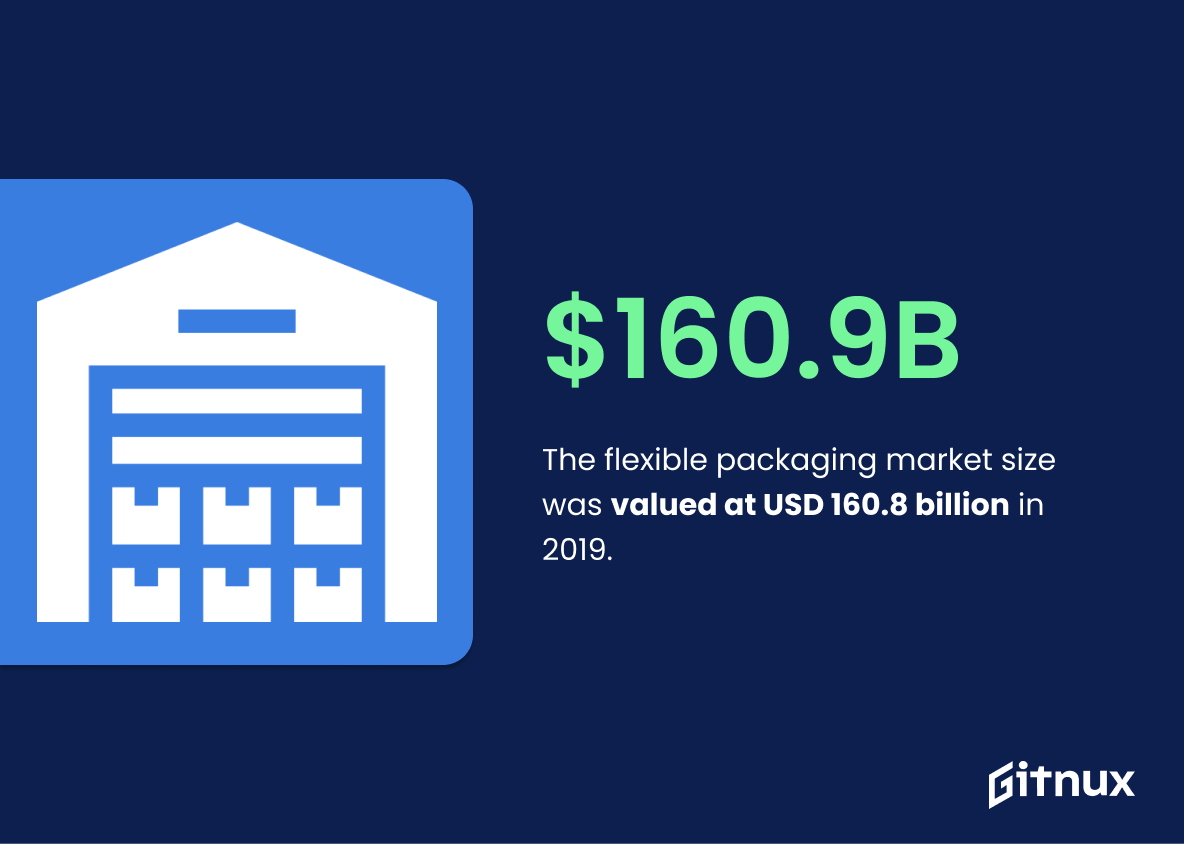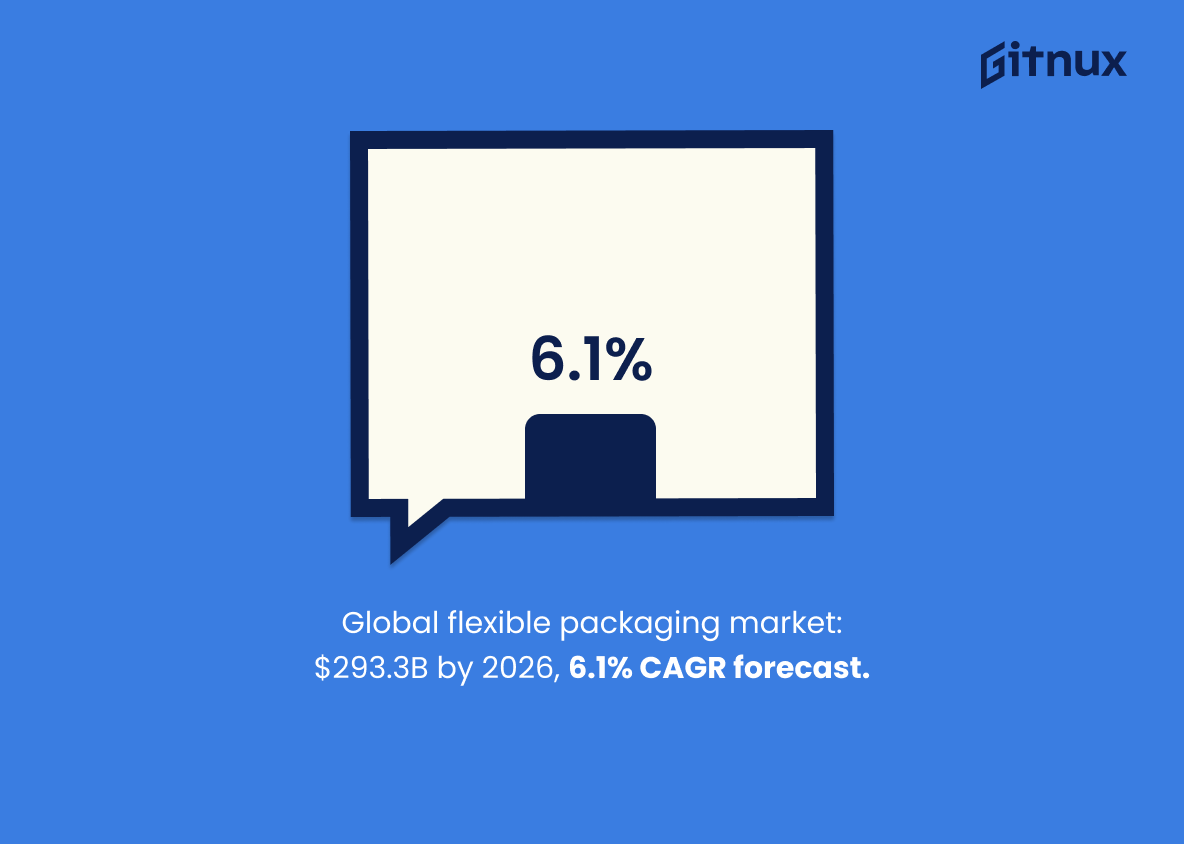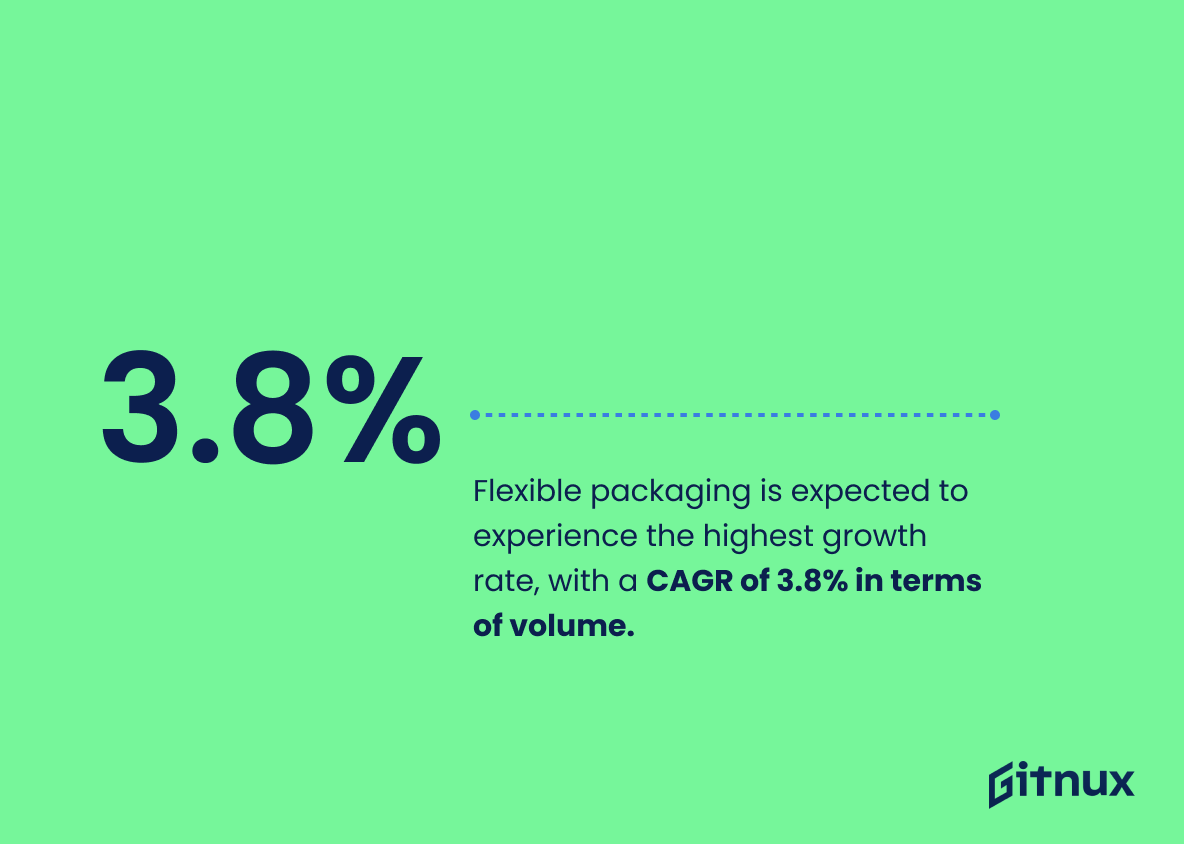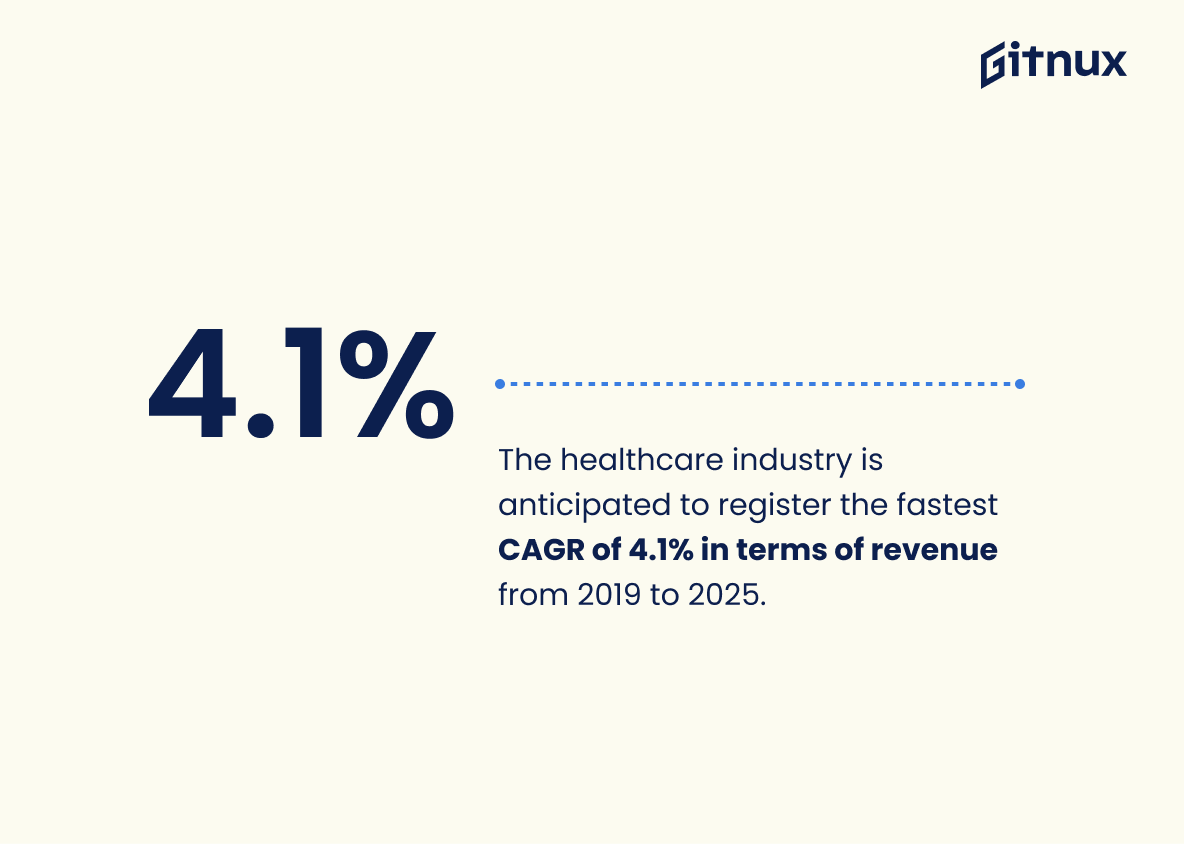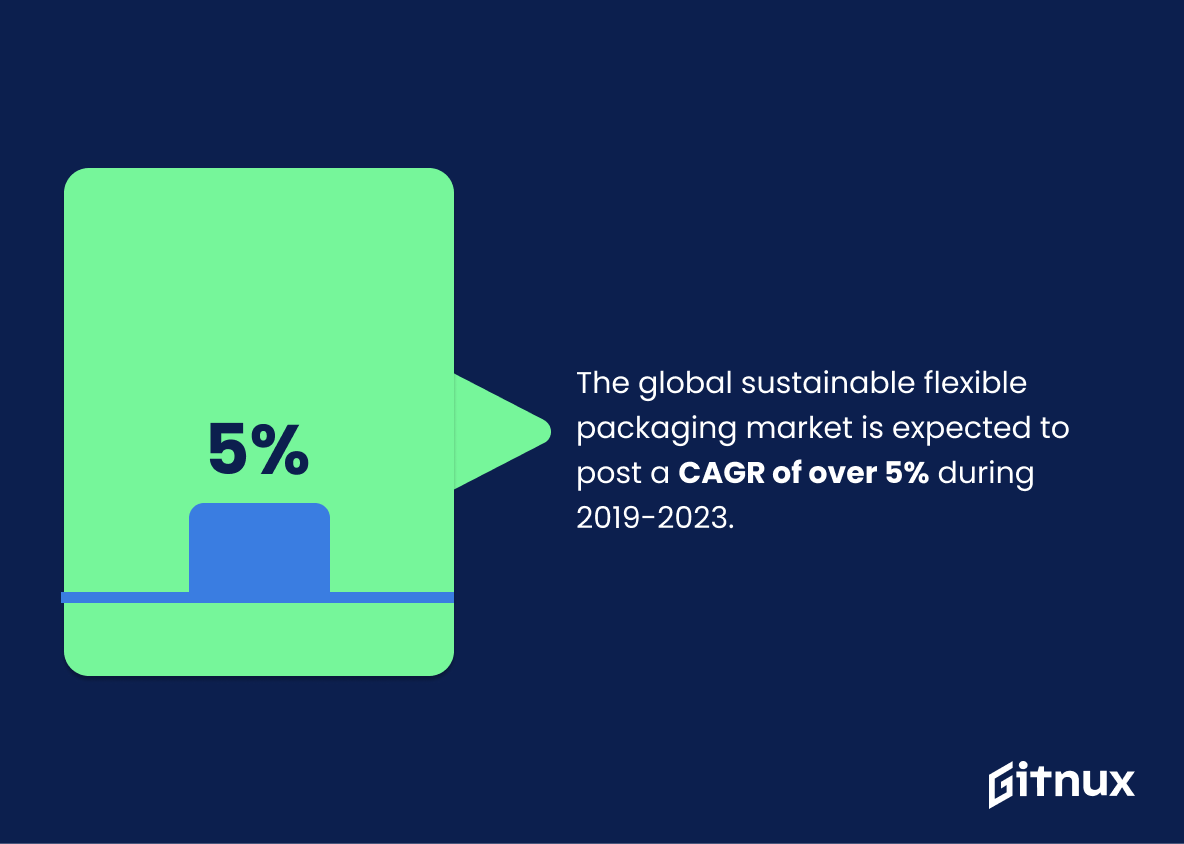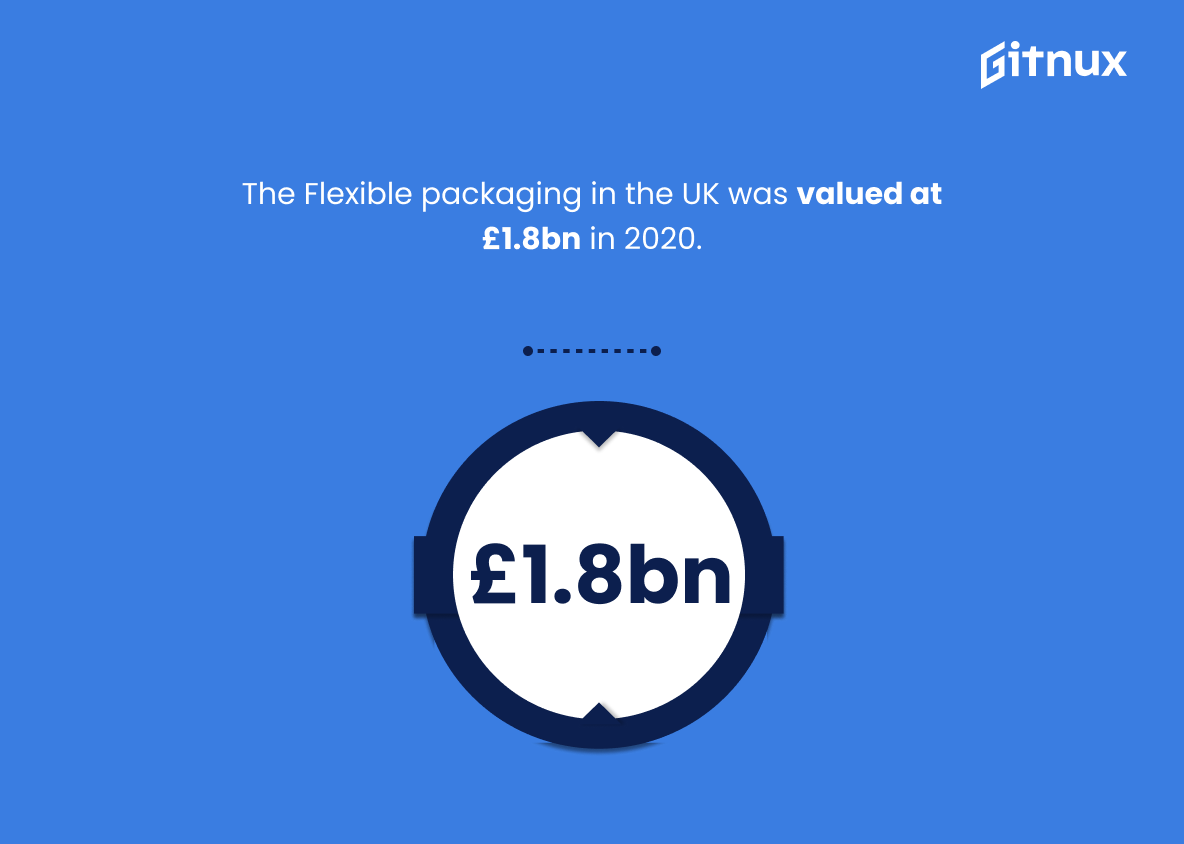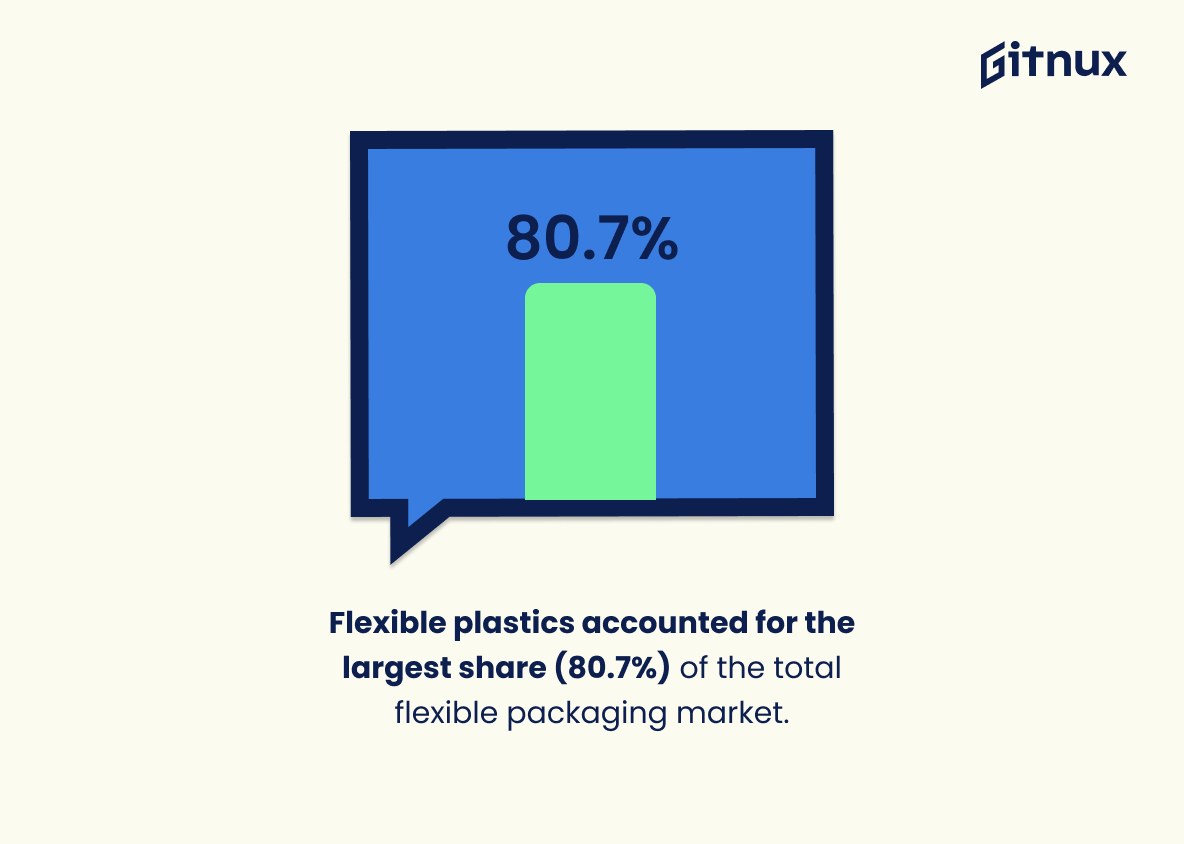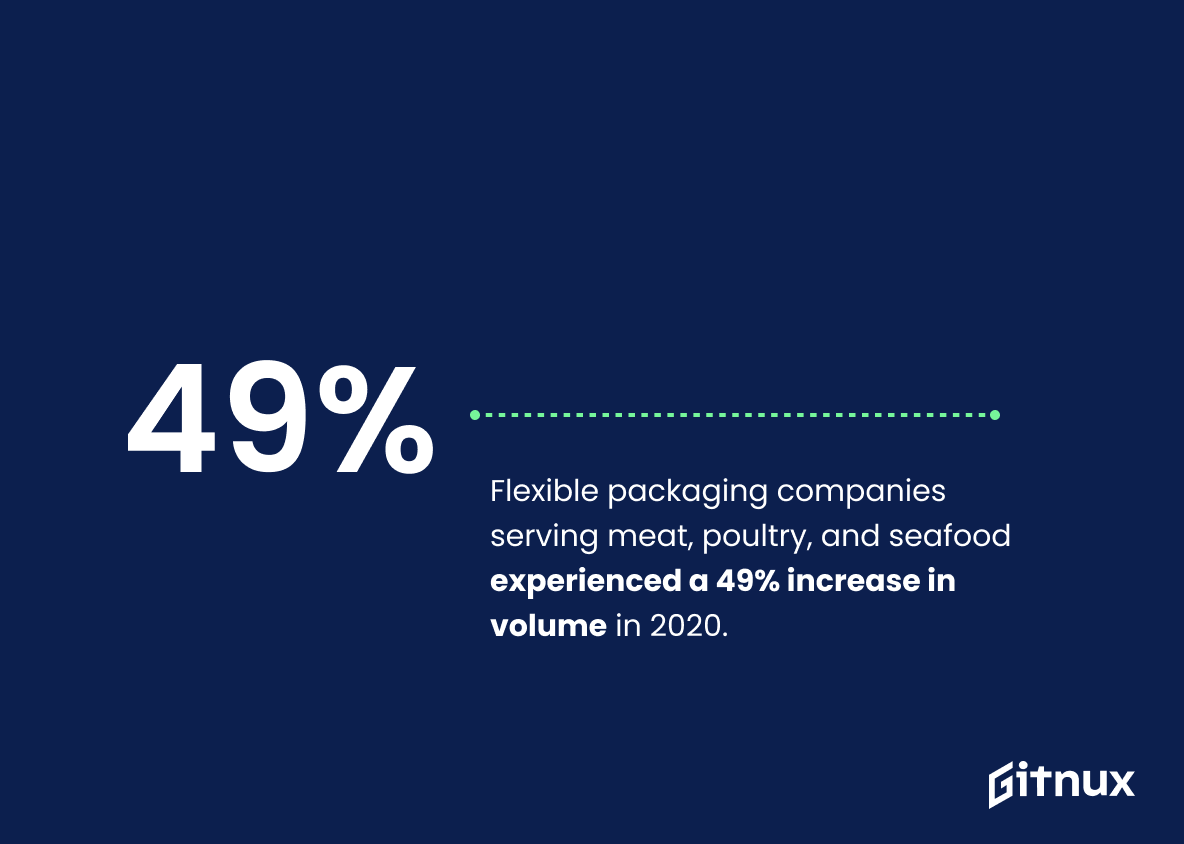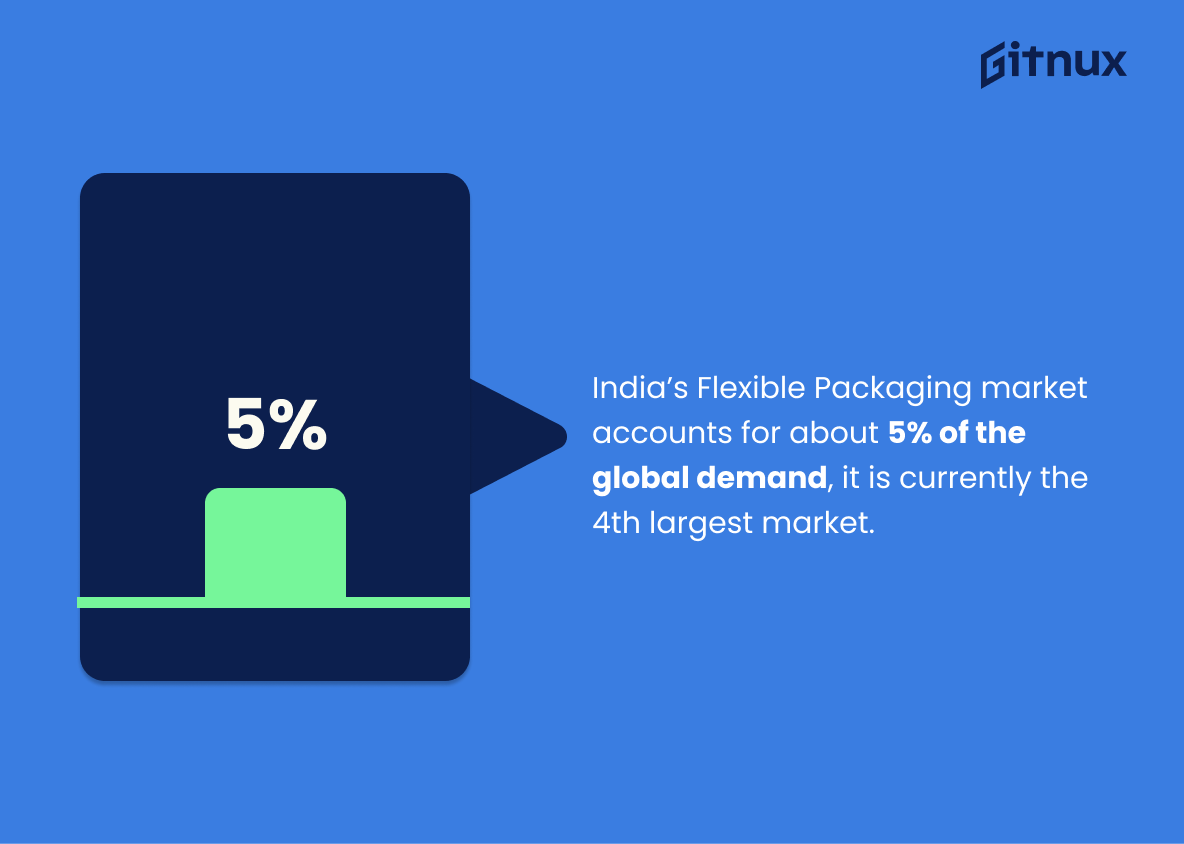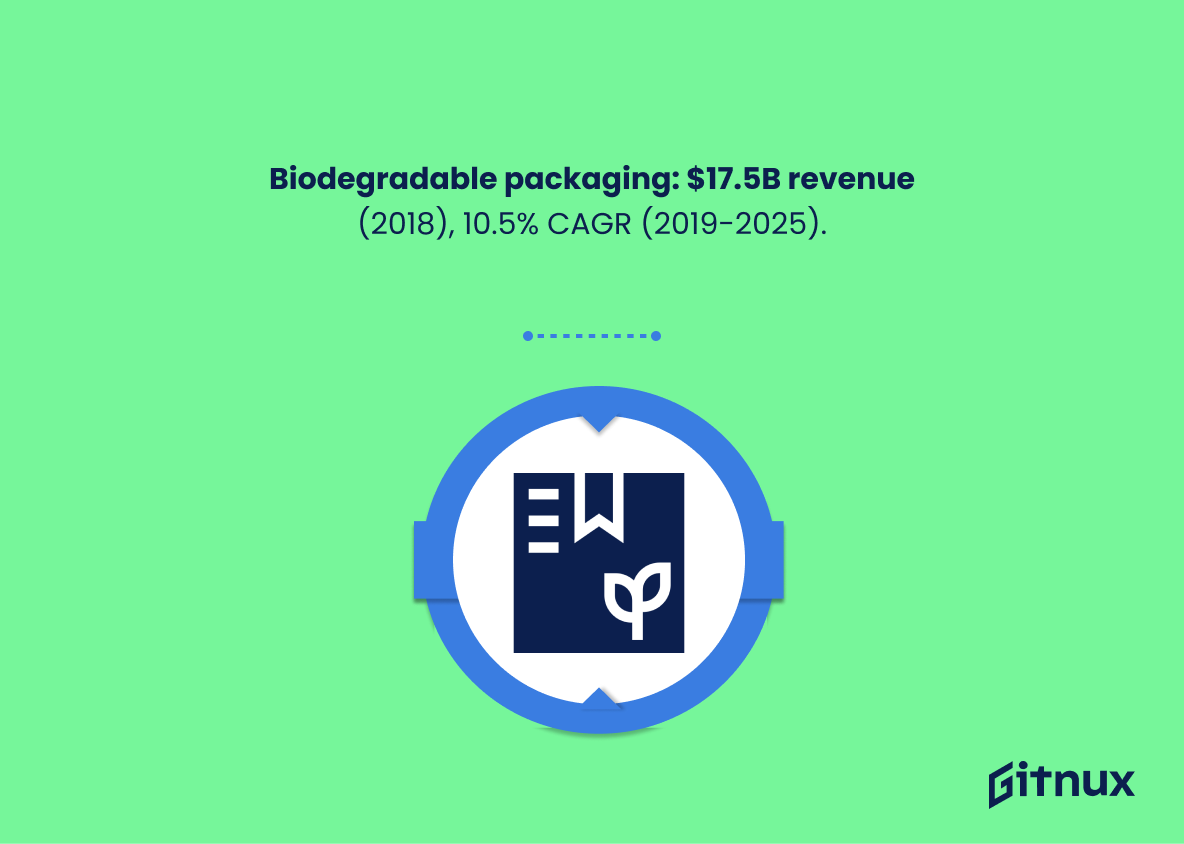In a world that is rapidly evolving with cutting-edge technologies and shifting consumer behaviors, the sphere of packaging is undergoing dynamic transformation. Specifically, the flexible packaging industry reflects a remarkable pace of growth and innovation. This blog post aims to delve into the fascinating realm of flexible packaging, scattering light on significant industry statistics.
Whether you’re a stakeholder in the packaging sector, a curious investor, or simply an interested reader, this insightful exploration of the key trends, figures, and future forecasts in the flexible packaging sector will surely cater to your curiosity. Prepare to be unraveled into a world where resilience meets flexibility and sustainability garners significant value.
The Latest Flexible Packaging Industry Statistics Unveiled
The flexible packaging market size was valued at USD 160.8 billion in 2019.
Brimming with illuminating insight, the snippet revealing the jaw-dropping valuation of the flexible packaging market at USD 160.8 billion in 2019 paints a lucid picture of the industry’s economic clout. It extends beyond bland numbers and morphs into an impactful testament of the industry’s flourishing prosperity and outstanding growth potential.
This particular statistic is a torch-bearer, igniting intriguing discussions regarding the future prospects of the flexible packaging industry. With this golden nugget of information, readers can uncover the tangible presence and spectacular influence of this realm on a global scale.
The Global Flexible Packaging Market size is expected to reach $293.3 billion by 2026, rising at a market growth of 6.1% CAGR during the forecast period.
Painting an elaborate picture of the robust growth trajectory in the global flexible packaging industry, the projected market size of $293.3 billion by 2026 certainly stands as a testament to the immense potential this sector holds. A steady market growth rate of 6.1% CAGR further fortifies the influential role of the sector in the coming years.
This fascinating development, revealed through this statistic, gives a glimpse of the burgeoning preference for flexible packaging solutions, driving influential market strategies, investment decisions and innovations. Envisioning the landscape of this industry, the statistic thereby stands significant, guiding those who are a part of this dynamic ecosystem to understand and unlock the future opportunities veiled within the folds of the global flexible packaging market.
Flexible packaging is expected to experience the highest growth rate, with a CAGR of 3.8% in terms of volume.
Reflecting on this forward-thinking data reveals a captivating trajectory for the flexible packaging industry. The projected CAGR of 3.8% in terms of volume indicates a dynamic and progressing curve of growth. Set to outpace other packaging modalities, flexible packaging is heading towards a future rich with opportunities, seizing the crown in the industry’s growth rate.
This number offers a beacon of insight, suggesting a flourishing landscape where businesses in this sector could potentially thrive, innovatively advance and robustly scale. Such a statistic isn’t just numbers on a page, but a forecast of potential windfalls and direction-setting trends in the flexible packaging industry.
The U.S. flexible packaging industry is estimated to be about $31.8 billion in annual sales.
The magnificent figure of $31.8 billion in annual sales towers in the panorama of the U.S. flexible packaging industry. This sensational statistic forms the financial backbone for an industry that simultaneously satisfies consumer convenience and caters to a broad range of sectors such as food and beverage, healthcare, personal care, and industrial applications. The statistic hails the industry’s commercial significance, testifying to its indispensability in our daily lives. It carves a measure of the industry’s health and dynamic growth, making it a lighthouse for potential investors navigating the investment seas.
When diving into an analysis of flexible packaging industry statistics, such a grand wave of sales revenue empowers us with an understanding of the industry’s profound market influence. In a world increasingly leaning toward sustainability, these numbers also echo the escalating adoption of flexible packaging solutions – a trend that’s swaying the scales of the packaging universe.
The stand-up pouches segment held the largest share in the flexible packaging market and was valued at USD 18.03 billion in 2019.
The stand-up pouches segment’s commanding position in the flexible packaging market, being valued at a whopping USD 18.03 billion in 2019, significantly frames the industry landscape. This colossal figure not only underscores the consumer preference and demand towards stand-up pouches but also offers a glimpse of where the industry’s focal point resides.
As such, it generates insights and wisdom for industry players to potentially shape their strategies, whether in product development or market expansion. Hence, this enlightening revelation indeed weaves a narrative that conveys a powerful story in a blog post examining the flexible packaging industry’s statistics. Unveiling such dramatic figures serves as a light, guiding the reader’s understanding of the market dynamics involved, and instills a proper perspective.
In 2019, the food & beverages segment dominated the market contributing to more than HALF of the total market share.
The aforementioned statistic weaves a relevant narrative for stakeholders in the Flexible Packaging Industry. It casts a spotlight on the dominance and influential role of the food & beverages sector in shaping the market trends. When this sector commanded over half of the total market share in 2019, it emphasized strongly weighted demand patterns within the packaging industry.
Essentially, it underscores the importance for companies within this industry to align their strategies and innovations towards the needs and preferences of the food & beverages sector, considering its substantial contribution to the market. Furthermore, the sheer volume this statistic signifies indicates a robust consumer base, promising growth potential, and clear trajectories for market expansion in the food & beverages segment. Therefore, it’s like a beacon, guiding entities within the flexible packaging industry towards areas of optimal engagement.
Plastic was the dominant material segment in the global flexible packaging market, accounting for a share of 70.2% in 2019.
In a blog post about Flexible Packaging Industry Statistics, highlighting that plastic constituted 70.2% of the global flexible packaging market in 2019, puts a powerful spotlight on the integral role this material plays in the sector. This figure underscores plastic’s prominent status, vividly illustrating how it has outperformed other materials within the industry.
Thus, any fluctuations in the production, supply, or demand of plastic would reverberate throughout the entire flexible packaging market, directly affecting its dynamics and future trends. Furthermore, this prevalence of plastic might also steer conversations and decisions relating to environmental sustainability within the industry, driving innovative alternatives or improved recycling practices.
The healthcare industry is anticipated to register the fastest CAGR of 4.1% in terms of revenue from 2019 to 2025.
An intriguing projection showcased by this statistic is the healthcare industry’s anticipated fastest Compound Annual Growth Rate (CAGR) of 4.1% in terms of revenue from 2019 to 2025. Delving into its significance in light of a blog post about Flexible Packaging Industry Statistics, one finds close ties and implications. Essentially, as the healthcare industry expands, so does its demand for flexible packaging solutions.
Products such as disposable medical supplies, over-the-counter medications, or prescription drugs – all require safe, secure and often bespoke packaging. Hence, a boom in the healthcare sector provides fertile ground for the flexible packaging industry to thrive and expand. Therefore, as the healthcare industry is expected to flourish at a rapid pace, immense opportunities are on the horizon for innovation, growth, and higher revenues in the flexible packaging arena as well.
The global sustainable flexible packaging market is expected to post a CAGR of over 5% during 2019-2023.
Draped in the vibrant hues of continuous growth, the global sustainable flexible packaging market is on a significant trajectory, flaunting a projected Compound Annual Growth Rate (CAGR) of more than 5% over the period from 2019 to 2023. This indicates an era of transformation and expansion, underscoring the potential for a variable business emphasis towards environmentally friendly packaging solutions.
Positioned within a blog post about Flexible Packaging Industry Statistics, this statistic becomes a centerpiece, serving as an eye-opening revelation of the upwardly mobile trends that are reshaping the fabric of the packaging industry. In essence, it’s not just about numbers or mere percentages; it’s a powerful testament to the surging wave of sustainable practices in the packaging world, echoing a promising future for investors, entrepreneurs, and consumers alike.
The Flexible packaging in the UK was valued at £1.8bn in 2020.
Treading the tightened ropes of the statistical world, one cannot ignore the financial testament that echoes from the heart of the UK’s flexible packaging market. It shouts out a towering £1.8bn valuation in 2020 – an inference that bolsters our insights into the scale of the market and the potential industry players have to amplify their profits.
Parting the gossamer of numbers, this valuation bespeaks the robust demand for flexible packaging services and products in the UK, manifesting the aura of opportunity that the sector espouses for vendors, clients, and buzzing entrepreneurs alike. Hence, the statistic is far from a mere number; instead, it’s an economic revelation that weaves a tale of a burgeoning industry marked by financial vitality and vibrant market potential.
80% of brand owners say they are strategically using flexible packaging right now.
Illuminating the landscape of the flexible packaging industry, we find a striking figure – a whopping 80% of brand owners proclaiming their strategic use of flexible packaging. This powerful data point serves as a beacon, highlighting the prevailing trend and demonstrating the industry’s succinct shift towards this packaging solution. This noteworthy trend unravels a story of transformation, showcasing how contemporary brand strategies are acknowledging and leveraging the numerous benefits of flexible packaging. Not merely a number, this percentage is a testament to the evolving ecosystem of the packaging world, piquing interest, shaping decisions, and setting the market’s pulse.
Flexible plastics accounted for the largest share (80.7%) of the total flexible packaging market.
Understanding that flexible plastics dominate the flexible packaging market with an imposing share of 80.7% is a crucial point for anyone involved or interested in this industry. It offers a prism through which they can grasp the industry’s current structure and dynamics. This revelation, seen in the context of a blog post about Flexible Packaging Industry Statistics, shines a spotlight on flexible plastics as an essential segment. It screams about the market’s preference for this material— possibly due to its cost-effectiveness, durability, light weight, and high recyclability potential.
Consequently, any dynamic in this segment such as an innovation, new regulations, or even a raw material scarcity could send shockwaves through the entire packaging industry. Hence, every industry stakeholder, be it a manufacturer, supplier, policymaker, or investor, should keep a close watch on the trends, opportunities and challenges in the realm of flexible plastics within the packaging industry.
Flexible packaging companies serving meat, poultry, and seafood experienced a 49% increase in volume in 2020.
This impressive uptick of 49% in volume for flexible packaging companies dealing with meat, poultry and seafood provides a vivid reflection of the industry’s robustness and adaptability, particularly during the rollercoaster year of 2020. Within the wider panorama of the flexible packaging industry, this surge acts as an exemplar of the industry’s buoyancy amidst market fluctuations and disruptions.
When discussing industry statistics in a blog post, this statistic is a compelling validation of the increasing reliance on flexible packaging within the food sector, particularly for perishable items such as meat, poultry, and seafood. This statistic not only underscores the essential role flexible packaging plays in the preservation and transportation of these items, but also infers its contribution to reducing food waste by extending the shelf-life of these products.
It further serves as a beacon of growth and opportunity within the industry. Companies invested in, or considering venturing into, flexible packaging for perishable foodstuffs can draw from this statistic to anticipate potential value propositions and growth trajectories.
Therefore, this 49% increase encapsulates how resilient and critical the flexible packaging industry is, making it an absolute protagonist in the narrative of our blog post. To ignore this statistic would be akin to skipping a crucial chapter in the story of the flexible packaging industry’s ongoing evolution.
India’s Flexible Packaging market accounts for about 5% of the global demand, it is currently the 4th largest market.
Highlighting that India, with its 5% share, is the fourth largest global consumer of flexible packaging, serves to underscore the immense potential and vitality of this sector. It adds a geoeconomic dimension to the discussion, drawing attention to the rapid market expansion in developing economies. This information not only introduces our readers to a vivid panorama of the worldwide flexible packaging market, but also armors them with pivotal insights for making informed, future-forward, investment and operational decisions in this industry.
Biodegradable flexible packaging market size exceeded USD 17.5 billion revenue globally in 2018 and is estimated to grow at over 10.5% CAGR between 2019 and 2025.
Unveiling the fascinating journey of the Biodegradable Flexible Packaging Industry, the numerical eye-opener takes centerstage – the market grew beyond a colossal USD 17.5 billion in revenue worldwide in 2018. This one seemingly simple number represents the astounding progress and reach of this industry in a short span of time.
But the dynamic story does not end here, the forecasted growth at a Compound Annual Growth Rate (CAGR) of over 10.5% between 2019 and 2025 shows that this industry is on an unstoppable upward trajectory. As we unfurl more data in this blog post about Flexible Packaging Industry Statistics, one cannot help but marvel on the resilience, potential, and limitless possibilities that lie within this industry.
By 2024, the flexible packaging market is estimated to reach around USD 299.78 billion in terms of revenue.
Highlighting forecasts such as these offers a peephole into the future, painting a vibrant picture of growth and potential within the flexible packaging industry. Stepping onto an imagined vantage point in 2024, we’re able to appreciate the grandeur of an environment pulsing with an estimated USD 299.78 billion revenue. This underpins the immense opportunities lying in the folds of this industry, standing testament to its dynamism and adaptability.
Hence, this future-oriented view serves to galvanize current industry stakeholders and also, summon potential investors to make the most of this surging tide. In essence, this compelling narrative of evolution underscores the sheer magnitude and influence of the flexible packaging sector in our daily lives and the global economy.
In 2021, retail flexible packaging papers amounted to 2.5 million tons, a 5 percent increase from the previous year.
Diving into the dynamic realm of flexible packaging, it’s undeniable the significance of the recent surge in retail flexible packaging papers. As we glance back at 2021, there’s an intriguing upward trajectory with a hefty weight of 2.5 million tons. Not just a nominal figure, but one that signifies a robust 5 percent ascent from the preceding year.
The heart of this data beats with several implications within the context of Flexible Packaging Industry Statistics then and now. For starters, it exhibits the thriving demand and consumption for flexible packaging solutions, indicative of a major economic uplift in the retail sector. Furthermore, the rhythm of this increase points to industries’ pivot toward sustainable, customizable, and cost-effective packaging solutions.
Thus, this transformative five percent leap affirms not only the growing market fortitude but also predicts a likely upward blueprint for the future of the flexible packaging industry. A surefire testament to industry resilience, adaptability, and progressive momentum.
The demand for flexible packaging is mainly driven by growth in the food and beverage industry, which accounts for around 70% of market demand.
Peering into the veritable crystal ball of the flexible packaging industry’s future, we find a silver line of wisdom. The food and beverage sector, representing an astounding 70% of the market demand, provides the leverage swinging the pendulum of growth in favor of flexible packaging. This monumental statistic is not just another number, but rather the north star, guiding entrepreneurs, investors, and innovators through the vast sky of the industry.
This integer, unassuming as it might initially appear, is an industrial titan casting its mighty shadow across the market landscape. A testament to the food and beverage industry’s insatiable appetite for flexible packaging, it illuminates the path of strategic opportunities for existing businesses and sows seeds for potential enterprises planting roots in industry soil. A key player among industry statistics, it is indeed the wind that sets the sails of the flexible packaging industry ship.
According to a study by the Flexible Packaging Association, the average consumer uses at least one flexible packaging product every day.
This compelling piece of information paints an intriguing canvas of the pervasive and indispensable role that flexible packaging plays in our daily lives. It underscores the enormity and influence of the industry, highlighting its omnipresence. Imagine, every day, every consumer interacts with at least one product of flexible packaging. It’s like the invisible thread weaving through our everyday narratives. By shedding light on the vitality of flexible packaging, it simultaneously signals an ever-growing market opportunity and underpins the substantial potential of this industry.
Through this lens, we understand that analyzing flexible packaging industry statistics isn’t just number-crunching, but a meaningful exploration of widespread consumers’ behaviors and marketplace dynamics.
Therefore, when we talk about the statistics of the flexible packaging industry, such figures aren’t just abstract details but vivid reflections of consumer habits, industry trends, and business opportunities. They paint a living, breathing picture of an industry that plays a substantial part in our daily routines, marketplace trends, and the global economy.
Conclusion
In the realm of packaging, the era of rigid, traditional methods is giving way to a new normal marked by creativity, efficiency and flexibility. The flexible packaging industry, bolstered by significant statistics, demonstrates a promising future with rampant innovations and sustainable solutions.
These burgeoning growth patterns underline the fact that flexible packaging is not just a fleeting trend, but a substantial pivot in the global packaging sector, influenced by environmental awareness, technological advancements, and evolving consumer preferences. By embracing the flexible packaging evolution, businesses can expect to enjoy considerable economic benefits, enhanced brand value, and the satisfaction of contributing to a sustainable future.
References
0. – https://www.www.kbvresearch.com
1. – https://www.finance.yahoo.com
2. – https://www.nalhonafinch.medium.com
3. – https://www.www.zionmarketresearch.com
4. – https://www.www.flexpackmag.com
5. – https://www.www.polymersolutions.com
6. – https://www.packagingindustryreports.com
7. – https://www.www.thomasnet.com
8. – https://www.packagingeurope.com
9. – https://www.www.plasticstoday.com
10. – https://www.www.grandviewresearch.com
11. – https://www.www.businesswire.com
12. – https://www.www.flexpack.org
13. – https://www.www.flexpackvoice.com
14. – https://www.www.technavio.com
15. – https://www.www.gminsights.com
16. – https://www.www.researchandmarkets.com
17. – https://www.www.emergenresearch.com
